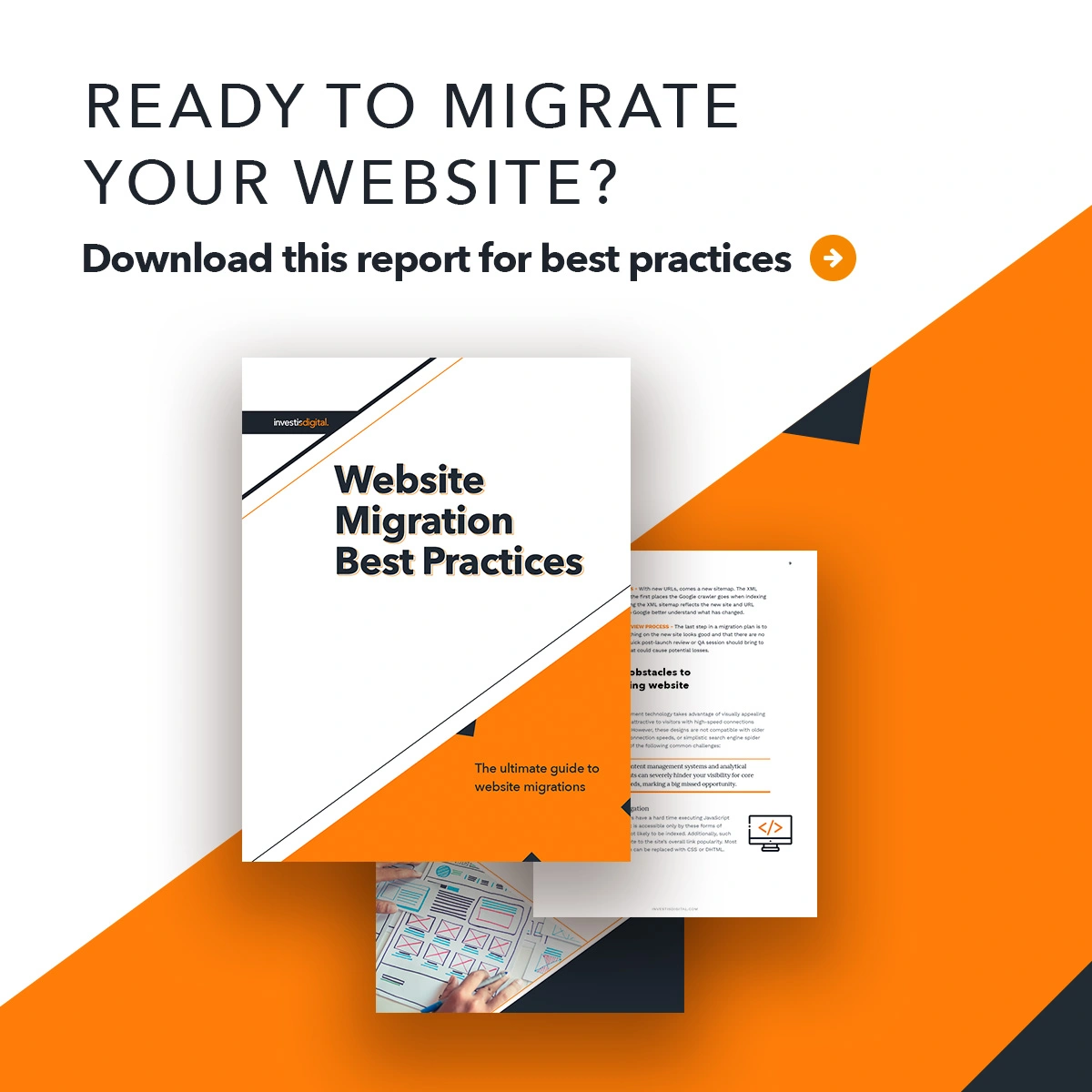The 7 Top Risks of Website Migration and How to Avoid Them

Website migrations are complex and if not approached correctly, serious consequences can arise. If you are operating a business that relies on website uptime and organic visibility, a poorly executed migration can lead to major revenue drops. By understanding the hazards associated with site migration, you can plan and mitigate the potential risks. There are seven common risks you may confront during a site migration. Read on to learn the steps to take to reduce these risks.
1. Potential organic traffic, ranking, or conversion rate decline
- Problem: It is common for the traffic and rankings to fluctuate following a site migration, but there are steps that you can take to mitigate those losses.
- Solution: Ensure you have a migration plan in place with detailed URL mapping from historic to new URLs. In addition, ensure there are as few content gaps as possible between the old and new sites.
2. Increase in bounce rate due to lack of landing page relevancy
- Problem: Some pages may end up getting redirected to new content that is not quite “relevant enough.” If a user lands on a page that isn’t relevant to their search, they may leave the page quickly, resulting in an increased bounce rate.
- Solution: Ensure content mapping is discussed during the migration planning phase. Gaps in content relevancy may bring insight into which content pieces need to be migrated to maintain a similar traffic flow.
3. Website downtime
- Problem: Migrations come with some website downtime, which can result in loss of traffic, conversions, and revenue, depending on the site and industry.
- Solution: Ensure the migration plan has a firm launch date with a step-by-step process. Do not take down the existing site before the new site is ready to launch and implement redirects as soon as possible.
4. User experience interruption
- Problem: Users get accustomed to navigating a site the same way they did in the past and changing the structure or navigation of a site can lead to an interruption of user experience.
- Solution: Detailed redirect mapping is key for this. Ensuring redirects are implemented on all pages receiving traffic within the last year will help automatically guide users to the new corresponding page.
5. Analytics or tracking issues
- Problem: The analytics or tracking codes on a site can get lost, changed, or removed during website migrations, which causes irrecoverable data loss.
- Solution: Keep analytics and tracking codes the same throughout the migration and ensure they are implemented on the new site.
6. Indexation Bloat
- Problem: Indexation bloat occurs when there are too many URLs being crawled and indexed by Google. The main causes of this are not implementing redirects in a timely manner or not updating or submitting the sitemap of the new site in Google Search Console.
- Solution: Implement redirects in a timely manner and resubmit the new sitemap via Google Search Console.
7. Broken internal links and external backlinks
- Problem: When the website URLs change, existing internal links and external backlinks will then take the user to a 404-error page since that URL is no longer live.
- Solution: Update and optimize existing or new internal links on the new site. Reclaim historic external backlinks to pass equity to the new pages (301 redirects help some with this but updating the backlinks to the new URL is better).
Have a site migration coming up?
Now that you know the risks associated with site migrations (and how to avoid them) you can begin to plan for your own successful move. To make sure your migration goes off without a hitch, be sure to download our latest guide, “Website Migrations Best Practices,” for information about:
- Why you need a migration plan
- URL equity
- Migration types and situations
- Migration process and best practices
We have also included a full migration checklist in the guide so that you can stay on top of the process and avoid any potential risks.

Need more information or support on your next site migration? Feel free to contact us or learn more about our search engine optimization services.
- Introduction
- 1. Potential organic traffic, ranking, or conversion rate decline
- 2. Increase in bounce rate due to lack of landing page relevancy
- 5. Analytics or tracking issues
- 4. User experience interruption
- 5. Analytics or tracking issues
- 6. Indexation Bloat
- 7. Broken internal links and external backlinks
- Have a site migration coming up?
Let's chat
Whether you're looking for service, support or a future strategic partner - we're here to help.
Offices
LDN
London, UK
A mixing pot of every colour, from red buses to black cabs.
Counting House
53 Tooley Street
London
SE1 2QN
GOT
Gothenburg, Sweden
A vibrant city with a rich maritime history.
Hälsingegatan 12
414 63 Gothenburg
Sweden
HEL
Helsinki, Finland
Don’t let the cold scare you off, our office is nice and warm.
Mannerheiminaukio 1 A
FI-00100 Helsinki
Finland
VAD
Vadodara, India
Enter our bustling world of great people and even greater food.
Business Park East, Alembic Road
Vadodara-390003, Gujarat , India
PHX
Phoenix, USA
Visit our oasis in the desert where the sun never stops shining.
11201 N Tatum Blvd, #200
Phoenix, AZ 85028
NYC
New York City, USA
You won’t find a better bagel anywhere else in the world.
240 W 37th Street, 7W
New York, NY 10018
